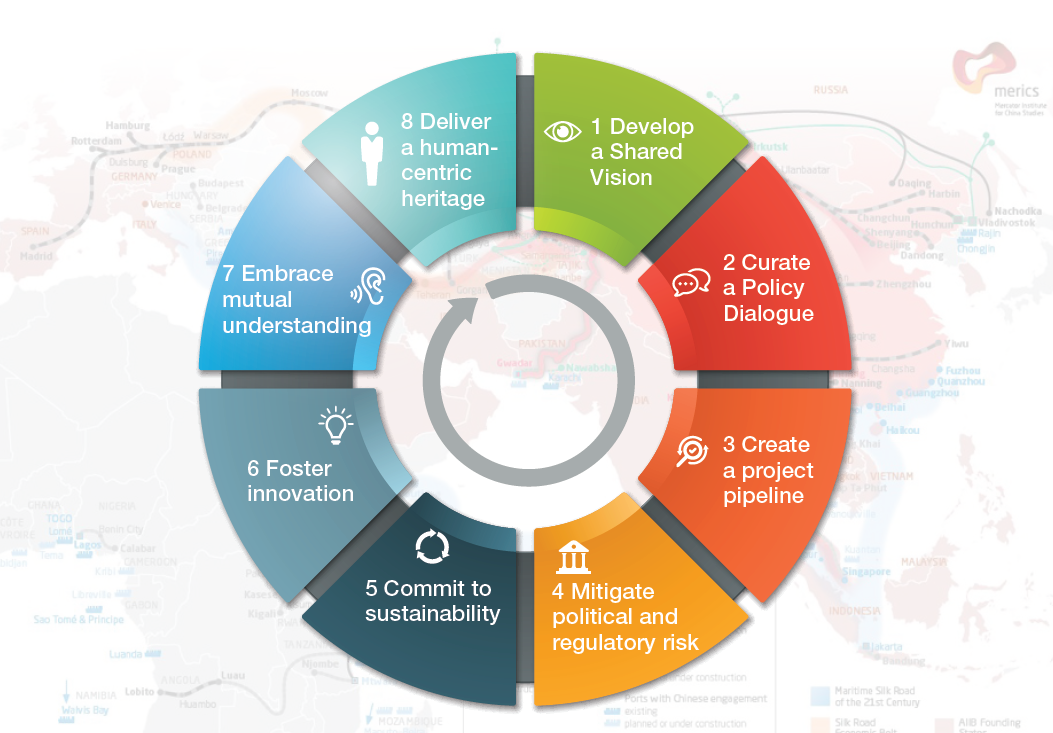The New Silk Road
Contents |
[edit] What is the New Silk Road?
The Silk Road was the name given in 1877 by the German geographer Ferdinand von Richthofen to the ancient network of trade routes linking China to central and western Asia, India and the Mediterranean region.
Today, China is breathing new life into the Silk Road with the goal of forging stronger relationships with its neighbours through the development and sharing of resources.
President Xi Jinping, speaking at the World Economic Forum 2017 in Davos, referred to the ancient Silk Road, highlighting the fact that international trade is an inherent human activity that helped in the past to maintain peace and stability over long periods of time.
[edit] What is its potential?
Today, the New Silk Road, or what is known as the Belt and Road Initiative (BRI), has the potential to prompt a profound shift in the global order towards a new multilateralism. In a narrow sense, the BRI is primarily a strategic infrastructure initiative of historic proportions. The planning and delivery of scalable infrastructure for power generation, transportation, water supply, and telecommunications will bring much-needed economic and societal connectivity to the 65 countries along this new network.
Through the BRI, China is proposing to share its immense financial and industrial resources and capabilities, as well as its experience of four decades of reform and opening-up, while securing its own long-term development.
The BRI makes a unique contribution to international cooperation and economic development: it is based on the stakeholder approach, it seeks to leverage market forces in best ways, it prepares best for the age of the Fourth Industrial Revolution, it is built on the open-platform concept and, most importantly, it is the positive narrative the world needs.
The BRI has five major goals: policy coordination; facilities’ connectivity; unimpeded trade; financial integration; and people-to-people exchange.
Beyond the initial commitment by the Chinese government of about $1 trillion in infrastructure development, which conservative estimates believe to be viable, the BRI will require roughly an aggregate of $6 trillion for the next 15 years to finance infrastructure projects fuelling the Belt and Road economies.
During that period, the Chinese plan to cumulatively invest $4 trillion in total – about 20 times the size of the post-Second World War Marshall Plan investment of $17 billion, which has a value of about $190 billion today. Several multilateral development banks have also committed to support the BRI to accomplish those ambitious goals and finance BRI-related projects.
[edit]
To avoid being locked into unsustainable patterns of development, which has been the common pitfall of large-scale strategic infrastructure projects, we anticipate eight transformation factors that have the potential to provide high-level stewardship for the BRI and revive the spirit of shared prosperity. These insights are derived from several years of analysing the infrastructure industry and its development projects.
To avoid being locked into unsustainable patterns of development, which has been the common pitfall of large-scale strategic infrastructure projects, we anticipate eight transformation factors that have the potential to provide high-level stewardship for the BRI and revive the spirit of shared prosperity. These insights are derived from several years of analysing the infrastructure industry and its development projects.
[edit]
Achieving transnational and international support for a shared vision for strategic infrastructure development that promotes wellbeing and a national sense of purpose to the communities beyond national borders.
[edit] Multilateralism
Curating an open and multilateral policy dialogue that addresses public-private-civic cooperation, early-stage project financing, standardized procurement and transparency, to level the playing field and build trusted relationships.
[edit] Project-preparation facility
Creating an infrastructure project-preparation facility to ensure a pipeline of bankable projects and a transnational centre of excellence to deliver the largest portfolio of projects ever.
[edit] Risk mitigation
Proactively mitigating political and regulatory risk to boost stakeholder engagement and confidence in the plan by investors, off-takers and operators.
[edit] Sustainable development
Committing to sustainability, inclusion and affordability principles to generate value for future generations beyond Agenda 2030.
[edit] Innovation
Enhancing technological and business model innovation for sustained value creation, ensuring readiness for the future.
[edit] People-to-people exchange
Governing domestic and cross-border migration and promoting mutual learning and understanding, to enable and deepen people-to-people exchange and transnational cultural cooperation, ensuring transcendent growth and universal purpose.
[edit] Human-centric and future-ready
Delivering the new humane infrastructure heritage beyond the current infrastructure usage for the next millennium.
Read more on what it takes to implement the eight steps towards shared prosperity and a sustainable future here.
Written by
- Michael Buehler, Head of Infrastructure & Urban Development, World Economic Forum
- Thorsten Jelinek, Director, Taihe Institute
- Sergio Gusmao Suchodolski, Director General, Strategy and Partnerships, New Development Bank (NDB)
- Pedro Rodrigues De Almeida, Member B20 Task Force on Financing Growth & Infrastructure, B20 Germany
- Olivier M. Schwab, Head of Business Engagement - Member of the Managing Board, World Economic Forum
[The views, opinions and positions expressed by author Sergio Suchodolski are his alone, and do not necessarily reflect the views, opinions or positions of the New Development Bank.]
--Future of Construction 13:39, 24 Oct 2017 (BST)
[edit] Find out more
[edit] Related articles on Designing Buildings Wiki
- A better investment framework for Africa.
- China - clean, green buildings of the future.
- How Latin America and the Caribbean can unlock their digital potential.
- India needs to build more infrastructure fast. Here’s how.
- Scoping project approach in the developing world.
- State of the construction industry in Uganda.
- These giant infrastructure projects are set to reshape Africa.
- Top architectural wonders of Dubai.
- Why the West has to join the Belt and Road Initiative.
Featured articles and news
Latest Build UK Building Safety Regime explainer published
Key elements in one short, now updated document.
UKGBC launch the UK Climate Resilience Roadmap
First guidance of its kind on direct climate impacts for the built environment and how it can adapt.
CLC Health, Safety and Wellbeing Strategy 2025
Launched by the Minister for Industry to look at fatalities on site, improving mental health and other issues.
One of the most impressive Victorian architects. Book review.
Common Assessment Standard now with building safety
New CAS update now includes mandatory building safety questions.
RTPI leader to become new CIOB Chief Executive Officer
Dr Victoria Hills MRTPI, FICE to take over after Caroline Gumble’s departure.
Social and affordable housing, a long term plan for delivery
The “Delivering a Decade of Renewal for Social and Affordable Housing” strategy sets out future path.
A change to adoptive architecture
Effects of global weather warming on architectural detailing, material choice and human interaction.
The proposed publicly owned and backed subsidiary of Homes England, to facilitate new homes.
How big is the problem and what can we do to mitigate the effects?
Overheating guidance and tools for building designers
A number of cool guides to help with the heat.
The UK's Modern Industrial Strategy: A 10 year plan
Previous consultation criticism, current key elements and general support with some persisting reservations.
Building Safety Regulator reforms
New roles, new staff and a new fast track service pave the way for a single construction regulator.
Architectural Technologist CPDs and Communications
CIAT CPD… and how you can do it!
Cooling centres and cool spaces
Managing extreme heat in cities by directing the public to places for heat stress relief and water sources.
Winter gardens: A brief history and warm variations
Extending the season with glass in different forms and terms.
Restoring Great Yarmouth's Winter Gardens
Transforming one of the least sustainable constructions imaginable.

























